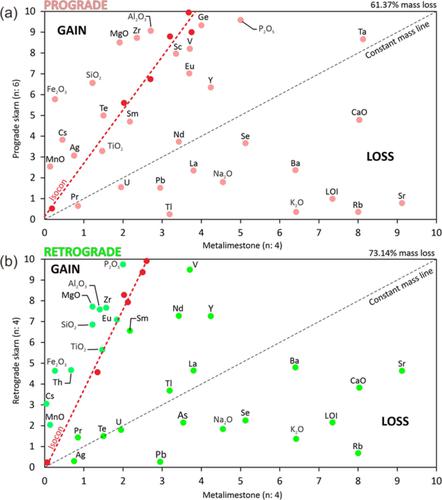Element mobility during formation of the Ruwai Zn‐Pb‐Ag skarn deposit, Central Borneo, Indonesia
IF 0.8
4区 地球科学
Q3 GEOLOGY
引用次数: 4
Abstract
The Ruwai deposit is Indonesia's largest Zn‐Pb‐Ag skarn deposit and is located in Lamandau district, Central Borneo, within the Central Borneo metallogenic belt. This skarn deposit consists of four main zones, namely Gojo, Karim, Ruwai, and Southwest Gossan Zones. The skarn orebodies are mostly hosted by limestone of the Jurassic Ketapang Complex where quartz diorite of the Cretaceous Sukadana Granitoid is the ore‐causative intrusion. Despite the several mineralogical studies carried out in this deposit, there is still a lack of knowledge of its geochemical characteristics. This study evaluates the element mobility during skarn formation on the basis of skarn and ore mineralogy combined with lithogeochemical data of the intrusions, sedimentary wall rocks, and skarn bodies. The skarn mineralogy of the Ruwai skarn complex can be divided into prograde, retrograde and supergene stages. The prograde stage is characterized by the formation of an anhydrous assemblage of garnet‐pyroxene, while the retrograde stage features the replacement of prograde minerals by predominant epidote‐chlorite‐actinolite. The mineralization was first introduced during the late prograde stage, while the formation of massive orebodies attributed to the retrograde stage. The skarn samples show a wide range of major element contents, but both the mineralized skarn and massive orebodies show similar trace and rare‐earth elements patterns in global Phanerozoic limestone‐ and upper crust sedimentary rocks‐normalized spider diagrams. The skarn and orebodies, as well as the metalimestone in this study area, are depleted in REE, although HREE are higher than LREE. Most metals (e.g., Zn, Pb, Ag, Cu, Fe) in skarn and associated orebodies, interpreted to be predominantly magmatic‐sourced, show co‐occurring enrichment or depletion relative to the metalimestone and intrusive rocks. The isocon analysis shows that there was significant mass loss as a consequence of significant volatile loss, such as CO2, during skarn formation. Major oxides and large ion lithophile elements mostly behaved as mobile elements during skarn formation, whereas rare‐earth and high field strength elements tended to be immobile. However, the occurrence of several HFSE‐ and REE‐bearing minerals in Ruwai deposit (i.e., zircon, thorite, cerite, cerianite, monazite, allanite), suggesting minor or local mobility of these elements. Such unexpected behavior can be justified by the occurrence of fluorine‐rich hydrothermal fluid, which could have been responsible for the increasing mobility of these elements.

印度尼西亚中婆罗洲Ruwai Zn - Pb - Ag矽卡岩矿床形成过程中的元素迁移
Ruwai矿床是印度尼西亚最大的锌Pb银矽卡岩矿床,位于婆罗洲中部的Lamandau地区,处于婆罗洲中部成矿带内。该夕卡岩矿床由四个主要带组成,即Gojo带、Karim带、Ruwai带和Gossan西南带。矽卡岩型矿体主要赋存于侏罗纪卡塔邦杂岩的灰岩中,其中白垩系苏卡达纳花岗岩类石英闪长岩为成矿侵入物。尽管对该矿床进行了几次矿物学研究,但对其地球化学特征仍缺乏认识。本文以矽卡岩和矿石矿物学资料为基础,结合侵入体、沉积围岩和矽卡岩体的岩石地球化学资料,评价了矽卡岩形成过程中元素的迁移性。如外夕卡岩杂岩的矿物学可分为进、退、表生三个阶段。前进阶段的特征是形成无水的石榴石-辉石组合,而倒退阶段的特征是由主要的绿帘石-绿泥石-放线石取代前进矿物。成矿作用最早出现在晚期进积期,而块状矿体的形成则归于退积期。矽卡岩样品显示出广泛的主要元素含量,但矿化矽卡岩和块状矿体在全球显生宙石灰岩和上地壳沉积岩中显示出相似的微量元素和稀土元素模式-标准化蜘蛛图。研究区矽卡岩、矿体及金属岩均为稀土贫化,但HREE高于LREE。矽卡岩及其伴生矿体中的大多数金属(如锌、铅、银、铜、铁),被解释为主要来源于岩浆,相对于金属岩和侵入岩,表现出共生富集或贫化。等同位素分析表明,在矽卡岩形成过程中,由于挥发性物质(如CO2)的大量损失,造成了显著的质量损失。主要氧化物和大离子亲石元素在矽卡岩形成过程中主要表现为可移动元素,而稀土和高场强元素则倾向于不移动。然而,在如外矿床中出现了几种含HFSE和REE的矿物(即锆石、钍矿、铈矿、铈矿、独居石、allanite),表明这些元素具有轻微或局部的可移动性。这种意想不到的行为可以被富氟热液的出现所证明,这可能是这些元素流动性增加的原因。
本文章由计算机程序翻译,如有差异,请以英文原文为准。
求助全文
约1分钟内获得全文
求助全文
来源期刊

Resource Geology
地学-地质学
CiteScore
2.30
自引率
14.30%
发文量
18
审稿时长
12 months
期刊介绍:
Resource Geology is an international journal focusing on economic geology, geochemistry and environmental geology. Its purpose is to contribute to the promotion of earth sciences related to metallic and non-metallic mineral deposits mainly in Asia, Oceania and the Circum-Pacific region, although other parts of the world are also considered.
Launched in 1998 by the Society for Resource Geology, the journal is published quarterly in English, making it more accessible to the international geological community. The journal publishes high quality papers of interest to those engaged in research and exploration of mineral deposits.
 求助内容:
求助内容: 应助结果提醒方式:
应助结果提醒方式:


